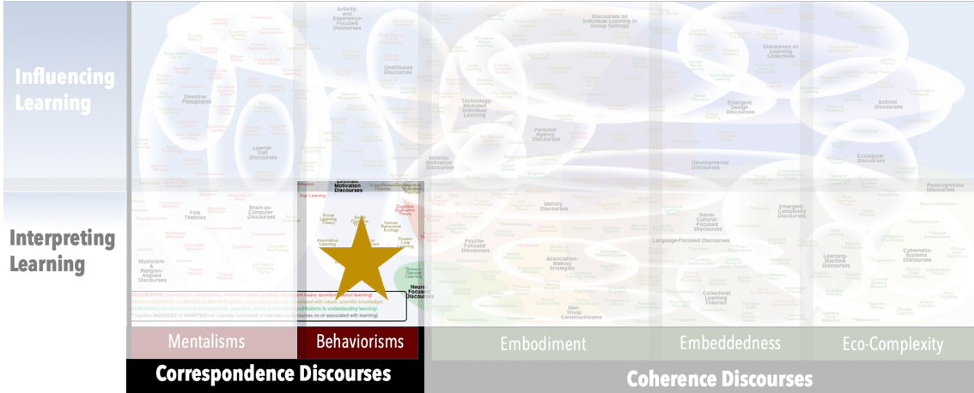Focus
Behavioral perspective on language and higher cognitionPrincipal Metaphors
- Knowledge is … higher-order, language-mediated cognition
- Knowing is … activating relations (among bits of knowing)
- Learner is … a combiner (individual)
- Learning is … relating (bits of knowing)
- Teaching is … juxtaposing experiences
Originated
1990sSynopsis
Relational Frame Theory asserts that the unwillingness (and inability) of Behaviorisms to deal with complex cognitive capacities arises from their grounding metaphor, “learning is linking.” This linking metaphor, it is argued, is linear and reductive as it focuses only on a unidirectional connection between one stimulus and one response. In contrast, Relational Frame Theory proposes that “learning is relating,” thus invoking an image of multiple simultaneous associations among a range of influences that go in different directions and that are of varied strengths. Hence, whereas the classic linking metaphor was constrained to notions of sequences and chains (of learned behaviors), Relational Frame Theory’s relating metaphor opens up notions of webs and networks as multiple relational learnings are combined to enable complicated, surprising, and powerful events of cognition. Associated constructs include:- Relational Responding (Steven C. Hayes, 2000s) – an event of responding to a particular stimulus, framed by the recognition that there are usually multiple potential stimuli that exist and operate relative to one another. Subtypes of Relational Responding include:
- Nonarbitrary Relational Responding (Ian Stewart, John McElwee, 2000s) – Relational Responding that is based on size, texture, taste, loudness, or some other physical property of the available stimuli
- Arbitrary Applicable Relational Responding (Ian Stewart, John McElwee, 2000s) – Relational Responding that is based on an invented (e.g., a social convention) or accidental (e.g., a coincidence) relation to the available stimuli
- Mutual Entailment (Dermot Barnes-Holmes, 2010s) – a reminder that relations can usually be stated in different ways. For example, if it is known that A is older than B, then it can be derived that B is younger than A. Subtypes of Mutual Entailment include:
- Combinatorial Mutual Entailment – deriving a relation between two stimuli based on their relations with other stimuli. For example, if A is older than B, and B is older than C, then A must be older than C.
Commentary
Relational Frame Theory appears to address the most common and persistent criticism of Behaviorisms, namely that these theories do not (and perhaps cannot) account for creativity and higher-order thinking. Arguably, however, it may be little more than an update, as its major conceptual contribution is the substitution of temporally specific notion (i.e., the linking metaphor, which was inspired by nascent telephone technologies in the early-20thcentury) with another (i.e., the relating metaphor. which appears to be reflective of emergent technologies in the early-21st century). Other historical baggage of Behaviorisms, including the tendency to regard learners as insulated and isolated individuals, are left unchallenged. Consequently, it is not clear the discourse represents much of an advance at all.Authors and/or Prominent Influences
Steven C. HayesStatus as a Theory of Learning
Relational Frame Theory is specifically focused on interpreting the dynamics of learning, and so it is considered a theory of learning in this analysis.Status as a Theory of Teaching
Relational Frame Theory is not directly or centrally concerned with matters of teaching. It has served as the source of some recommendations, however – which, for the most part, complement and substantially extend notions of training inherited from other Behaviorisms.Status as a Scientific Theory
Proponents of Relational Frame Theory have claimed that it is supported by evidence from hundreds of empirical studies. Be that as it may, it is not clear that the discourse is attentive to – let alone critical of – assumptions on the nature and dynamics of learning that it brought forward from earlier Behaviorisms and other Correspondence Discourses. Consequently, Relational Frame Theory does not meet our criteria for a fully scientific discourse.Subdiscourses:
- Arbitrary Applicable Relational Responding
- Combinatorial Mutual Entailment
- Mutual Entailment
- Nonarbitrary Relational Responding
- Relational Responding
Map Location

Please cite this article as:
Davis, B., & Francis, K. (2022). “Relational Frame Theory” in Discourses on Learning in Education. https://learningdiscourses.com.
⇦ Back to Map
⇦ Back to List
